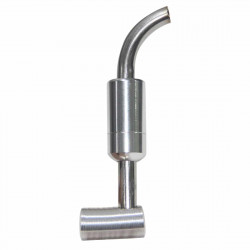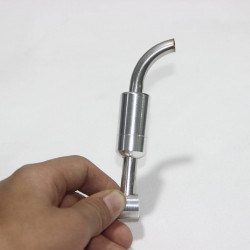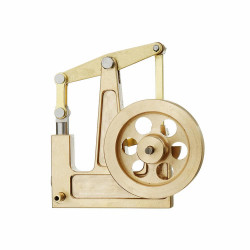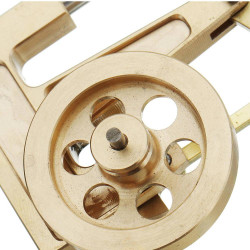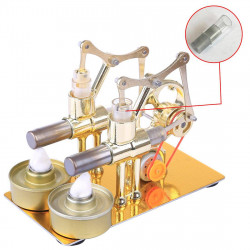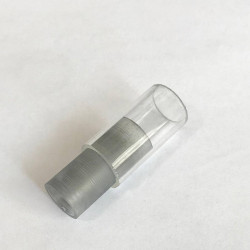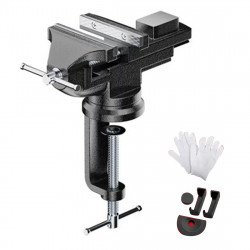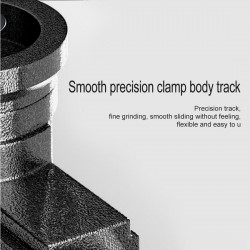
User Guide: A Detailed Manual for CISON FG-VT9 9cc V-twin V2 Engine
Before starting,
- Please check if the CDI is turned on. If it is off, turn on the switch.
- Then, spin the flywheel. Look for a strong spark at the top of the spark plug. If there is no high-voltage spark.
- Please check whether the power supply is connected.
- Whether the voltage is standard.
- Whether the hall sensor is damaged, etc.
- To ensure fuel enters the cylinder, turn the flywheel three times or more. Fully open the carburetor throttle. Then, use a hand drill or motor to start the engine.
- The carburetor needle may change significantly from the factory test since the fuel used may differ from yours. If you are unable to begin, kindly try.
- Try starting it after adjusting the main oil needle to 0.8–1.5 turns, but it might not be precise. Tank height, ambient temperature, and other factors could influence it. Please use your experience as a guide.
Oil: The engine's intended operating ratio is 25:1 when using two-stroke engine oil and fuel. You can also utilize Zippo fuel by mixing it with 2-stroke engine oil in a 25:1 ratio.
Fuel used: 95# and above gasoline
Lubricant: 2T engine oil
Mixing ratio: gasoline/oil=25/1
Lubrication method: Splash lubrication using mixed oil. The fluid falls freely through a main oil channel to the connecting rod.
Crankcase lubrication: Make sure the breathing port (vent) is clear. This allows lubricating oil to flow into the crankcase easily. However, you can later plug the vent to upgrade the separate lubrication system.
Fuel Tanks: There are several fuel tanks and containers available that are designed to be used with gasoline. Additionally, we provide fuel tanks for separate purchases. Please use a Tygon-type tube instead of silicone for extra fuel tubing. Silicone is not suitable for gasoline-based fuels.
Using tiny needle-nose pliers, you carefully connect the supplied gasoline line to the carburetor's inlet nipple. The Cison V-Twin engine's fuel line dimensions are 2.5 mm inside and 3 mm inside.
Needle: The high-speed fuel needle of the engine carburetor can be accessed from the engine's flywheel side. Although this needle is factory-calibrated, factors including fuel type, humidity, and altitude may require minor adjustments. To lean the mixture and enrich the fuel mixture, turn the needle adjustment clockwise or counterclockwise.
Idle speed: The little hex screw on the carburetor's side can be turned to change the idle speed. This screw sets the position of the throttle barrel.
To adjust the idle speed, close the throttle barrel opening. Turn the screw clockwise to raise the idle speed. Turn it counterclockwise to lower the idle speed.
Tool: A cordless drill's starter shaft starts the FG-VT9 engine. The rotation of the drill must be counterclockwise. Please be aware that a noticeable vibration "signature" associated with a 45-degree Vee angle engine is usual.
Ignition: The spark plugs receive power from the Hall-type ignition system. We advise using a LiPo battery with a JST-type socket that ranges from 6 to 7.2 volts. Attach the leads of each spark plug.
Verify that after you start the engine, the spark plug wires do not touch the flywheel. (You should use 4 packs of 1.5-volt cell batteries or the 6-7.4 V lithium battery.)
Exhaust:
- After inserting a green NBR O-ring into each exhaust port, thread the exhaust pipe bolts clockwise into each cylinder exhaust port to secure the exhaust tubes to the engine.
- Using a 10mm open-end wrench, snug the exhaust nuts.
- Avoid over-tightening.
Connection: Attach the three-wire connector plug of the ignition to the engine's ignition plug. The ground wire of the ignition is the solitary, solid black wire. Attach the ring termination of the wire to the bolt threaded in the engine's rear.
When you connect the ground ring terminal to the engine, you can use a spacer. This can be an M3 nut or some M3 washers.
Now it’s time to start your engine!
- Please fill the hole marked for the starter motor/generator location with 10ml of 2-stroke oil when the engine is ready to start. This will lubricate the engine's bottom end, camshaft, and camshaft drive before you start it for the first time.
- To prime the engine, turn the flywheel three complete revolutions by hand. Place the throttle lever back in the idle position.
- Connect the 6v - 7.2v battery to the ignition module. I recommend a 2s battery.
To start the engine, insert the starting shaft into the flywheel's center and turn the cordless drill counterclockwise. Once it starts, you can move the throttle lever arm to change the engine's RPM.
6. For a brief "breaking-in" period and to ensure that the engine is properly oiled, we advise keeping the engine's RPM low during the first few runs.
7. When a modest desktop-style fan is utilized while the device operates, the FG-VT9 dissipates heat effectively. Avoid touching the exhaust and cylinders while the engine operates because they get hot.
8. Crankcase venting is accomplished using the brass nipple at the engine's front. It is common for oil vapor to exit through this fitting; therefore, do not block it.
Common problem
The carburetor does not feed oil
A: Probably, the needle valve is entirely closed or blocked
Carburetor injection
A: Incorrect valve timing, valve leakage, too small valve clearance (correct 0.1mm)
Compression but not start-up
A: The power supply is dead, the sensor is damaged, and the CDI igniter is damaged.
Idle speed too high
A: Insufficient cylinder pressure, improper valve timing, imbalanced left and proper cylinder functioning, and improper carburetor commissioning
Suddenly, start without compression
A: It's conceivable that foreign material in the valve or the valve structure is mismatched.
Crankshaft abnormal sound
A: Because the crankshaft is a split structure, the crankshaft will likely be loose.
Engine Overheating
Check if the system releases heat. Make sure to use thinner gaskets to raise the compression ratio. Also, check if gasoline has lubrication.
How to Achieve Ultra-Low Idle Speed
A: Lower the compression ratio and swap out the large flywheel. If too much fuel and air mix fills the engine cylinders, follow these steps. First, take out the spark plugs and sealing washers. Use a 9mm socket for this.
Next, turn the engine upside down. Finally, turn the engine counterclockwise to let the extra gasoline drain out. To prevent fuel from possibly getting in your eyes, wear eye protection. The engine will not start if it is overflowing with gasoline.
Important: Do NOT attempt to start or rotate the flywheel if flooding occurs. Engine damage can occur.
Other Problems People May Ask
1. will you do a water-cooled version?
Not at this time. The only version we currently have is air-cooled.
Rather than being a high-performance machine, this v2 is a desktop computer. Thus, doing a water-cooling version is not very sensible. You can replace the external water pump and redesign the water channel yourself if you'd like.
2. Adjustable rockers or not?
Yes. this v2 has adjustable rockers and pushrods.
3. Does it leak?
Regardless of the engine, an excessively high valve gap will cause a leak. Increasing the atmospheric valve clearance can improve speed if it stays within a proper range.
4. What is the displacement?
9cc
5. Any turbo or supercharged engines?
Not at this time. It is challenging to make. We might carry it out later.
6. How is it carbureted, and what type of ignition timing ???
7. What about the oil pump?
The oil pump is still not freed. It's not too easy to accomplish.
8. Will this power my automobile? I need a new motor, and I'm not picky about size.
9. Why no valve covers
10. I run on a 1/5 scale of two strokes. They are all heavily modified 34cc. This engine would need more power, lol.
This model is an engine. Its size has to be more significant if we increase it to 34cc.
11. Does V2 have an output shaft? I mean, I will be able to hook it up to something, right?
12. I got the Cison FG-VT9 last week. The engine is charming, but Regretfully, it isn't operational.
I have constructed several engines and know a lot about them. The engine runs for two to three seconds after I start it, and it shuts off again.
I experimented with all possible carburetor settings and fuel combinations. It's either a lousy ignition or tax timings, I think. Moreover, there is relatively little compression in the front cylinder.
They have already sold me an M12 and an M16 engine, and I'm pretty happy with them. How do we move forward?
A: There is an issue with your v2's timing. After starting the ignition using the procedure below, be sure there is a spark in the high-voltage cable cap.
Due to customer input, we discovered that a few V2 engines' timing gear jacks did not reach the maximum tight fit. When the engine operates for an extended time, this could lead to timing misalignment.
If you experience timing issues after receiving the engine, please remove the cover and adjust the gear's top wire. Be careful when taking apart the gear to avoid removing the cover, as this can disrupt the timing.
Once you remove every screw, carefully shake the cover to ensure that the gears stay inside the crankcase. Next, locate and tighten the screw that corresponds to the illustration. You can disregard it if, after examining it, you discover that it is the tightest.
Technicians will fix all engines that come after using a keyway to eliminate the chance of timing mistakes.
How to Adjust the Timing?
a. First, ensure the magnet angle points in the direction indicated in the picture below. Next, attach the ground wire, high-voltage cap, and igniter. Finally, attach the Hall sensor wire.
Determine the correct lead angle by adjusting the gear. A 0–6° quality inspection can often reduce the idling speed.
b. Next, turn the flywheel to the setting in the second picture below. Please line up the flywheel hole with either the 0° or 10° middle screw. The engine usually works harder at 0°. Make sure the trigger magnet points up at this angle.
c.After that, install the camshaft so that the engine gearbox and the camshaft groove points are perpendicular.
13. My mini V twin panhead motor, which I bought for my bike shop display, ran flawlessly the first time I started it up and checked it out. The second time, it ran for a minute before suddenly dying. It appears that the CDI box stopped working, but it is still receiving power. I've only had it for a month.
Can I expect a CDI box from you? Tell me, please.
I appreciate your assistance. This little motor is the cutest.
A: If the CDI igniter has no spark, there may be a problem with the ignition or the hall sensor. The Hall sensor must detect induction to create a spark.
Therefore, we must first determine if the igniter or the Hall sensor is the issue. Please use the following procedure to check.
First, contact the black and white wire of the Hall sensor with tweezers or clips for the CDI igniter wire. Secondly, pull out the Hall sensor and igniter wiring heads. Then, use the Hall sensor wire to short-contact the black and white wires to check for sparks.
If a response is received, the Hall sensor isn't working correctly. Could you take off the Hall sensor and replace it? Reach out to me, and I'll email it again to you.
There is an igniter issue if there is no reaction. Take out the igniter. Reach out to me, and I'll email it again to you.
Please verify now and then get back to me.
So, how do you replace and install the new Hall sensor?
Please note that the new hall sensor is on the left. On the right is the old hall sensor.
a. To fix the Hall sensor, install it in the location indicated in the picture below and tighten the screws.
b. The new Hall sensor installation requires the placement of a gasket. The purpose of the gasket is to prevent the cylinder body and circuit board from making direct contact. The circuit board is too near to the cylinder, which makes it simple for the Hall to create a high-voltage circuit and malfunction.
c. As you can see, the trigger magnet for every new V twin engine is mounted in the flywheel. With the colored side facing out, insert the magnet into the slot and hole. Please do not install it backward; remember that.
14. Hi! I have the plan to buy a "Panhead engine." I have seen two different carburetors on it.
Why is that? I heard that there were some problems with the Hall sensor. Is that right?
A: Hello, the issue with the hall sensor has already been resolved. It is simple to desolder during operation because the 45° engine shakes a lot, and the solder junctions are weak. So, we modify the layout. The engines won't come off easily because a novel method of fixing integrates them.
In the experiment, we added a screw hole in version 2.0 for the Hall sensor. This means you won’t have to unscrew many parts to replace a broken Hall sensor; you just need to turn one screw. We can design a new bracket to ensure non-destructive installation if you don't want to drill holes in your machine. However, it might take some time.
And what we initially make and send is seen in the photo on the left. The picture on the right shows a client. He replaced the carburetor himself. He also adjusted the needle to improve the engine's idle.
15. What should I do if one of the cylinders does not fire and does not work?
The single carburetor causes uneven oil intake at idle speed. Its offset and the small intake pipe contribute to this issue. Additionally, a lack of run-in leads to unequal cylinder pressure on both sides of the engine. Thereby contributing to this issue.
The left cylinder is called the left cylinder. The right cylinder is called the right cylinder. This is when you face away from the flywheel.
First, adjust the carburetor. This will help you see if the engine cylinders can fire. Do this at medium and high speeds.
16. Why does it always happen that the cylinder on the right does not fire, but not the left?
When you remove the carburetor, you will notice that the air intake is slightly to the right. This causes more oil to enter on the right side when the throttle is at its lowest setting.
The carburetor can be placed sideways without a problem. However, this is not possible. Limited space restricts the engine to this specific design.
How can this issue be resolved?
1) Start by trying to swap out the high-voltage ignition wires. If the two new spark plugs work the same as before, we can rule out a circuit problem.
If there isn't a circuit issue, open the idling damper more—roughly 1-2 mm—and locate the two cylinders' balancing point. The situation should improve once he can run for 30 to 60 minutes.
Another effective method, though not usually recommended, is to use a 0.5mm drill bit. This bit can make a small hole in the intake pipe of the oil-rich cylinder. This hole helps the cylinder lower the negative pressure a bit. The likelihood of a missing cylinder misfire can also be decreased if the engine is loaded.
17. If the throttle is opened two millimeters, only the right cylinder will not operate. So, do I keep running in or stop running in?
Kindly keep opening the significant damper first. Try opening the oil needle more or less quickly at a low speed to see which side is receiving more oil if there is no change. Adjust the two slowly so they can hardly begin. Following some time of operation, it is steady.
Please check the lifter for the valve. If it’s not touching, the ignition won’t work, and the valve won’t open. The V2's structure causes strong vibrations, which sometimes make it shake and come loose from the top rod screw. Just be mindful of this minor detail.
Do we need to add lubricating oil to the side cover where the gears are located? Which one is appropriate?
The factory pre-greases the v2's gears and cam lobes. Given that grease will always be present on the camshaft, it is advised. The lubricating oil in liquid form will evaporate more quickly, and aging will not take long.
19. When you find that the rotating flywheel pushes the crankshaft bushing and the shaft to turn together, how do you adjust it?
If the bushing spins, you can fix it easily. First, use gasoline or other cleaners to clean around the bushing. Then, add more anaerobic glue. Rotate the bushing to help the glue soak in slowly.
